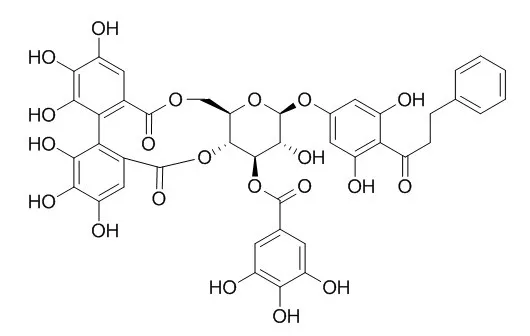| In vitro: |
| Food Funct. 2015 Aug;6(8):2588-97. | | Effects of thonningianin A in natural foods on apoptosis and cell cycle arrest of HepG-2 human hepatocellular carcinoma cells.[Pubmed: 26119846] |
METHODS AND RESULTS:
The anti-cancer activities of Thonningianin A on the HepG-2 human hepatocellular carcinoma cell line were evaluated by MTT assay, flow cytometry, quantitative real-time PCR and western blotting. Results showed that Thonningianin A effectively inhibited the proliferation of HepG-2 cells by inducing apoptosis, as evidenced by increase in the sub-G1 cell population, DNA fragmentation, and increase in the content of reactive oxygen species. Activation of caspase-9 and the subsequent activation of caspase-3 indicated that Thonningianin A-induced apoptosis is caspase-dependent. Thonningianin A also disrupted the mitochondrial membrane potential (Δψm) and down-regulated the Bcl-xL mRNA expression in HepG-2 cells. Thonningianin A induced cell cycle arrest by changing the cyclin D1 and CDK4 mRNA expression levels. Moreover, western blotting showed that Thonningianin A significantly down-regulated the NF-kappa-B cell survival pathway, along with up-regulation of the expression level of phosphorylated P38 and down-regulation of the expression level of phosphorylated ERK.
CONCLUSIONS:
The anti-cancer activity of Thonningianin A was confirmed by the characteristic patterns of DNA fragmentation and cell cycle arrest, suggesting that Th A is an effective antitumor ingredient in natural plant foods, and is worthy of further study. | | Biochem Pharmacol. 2002 May 1;63(9):1725-37. | | Antioxidant properties of Thonningianin A, isolated from the African medicinal herb, Thonningia sanguinea.[Pubmed: 12007576] | The antioxidant properties of Thonningianin A (Th A), an ellagitannin, isolated from the methanolic extract of the African medicinal herb, Thonningia sanguinea were studied using the NADPH and Fe2+/ascorbate-induced lipid peroxidation (LPO), electron spin resonance spectrometer and the deoxyribose assay.
METHODS AND RESULTS:
Thonningianin A at 10 microM inhibited both the NADPH and Fe2+/ascorbate-induced LPO in rat liver microsomes by 60% without inhibitory effects on cytochrome P450 activity. Thonningianin A was similar to the synthetic antioxidant, tannic acid, as an inhibitor of both the NADPH and Fe2+/ascorbate-induced LPO but potent than gallic acid, vitamin C and vitamin E. While Thonningianin A poorly scavenged the hydroxyl radical generated by the Fenton reaction it dose-dependently scavenged 1,1-diphenyl-2-picrylhydrazyl, superoxide anion and peroxyl radicals with IC50 of 7.5, 10 and 30 microM, respectively. Furthermore, Thonningianin A showed inhibitory effects on the activity of xanthine oxidase with an IC50 of 30 microM. In the deoxyribose assay both T. sanguinea and its methanolic component Thonningianin A showed only site-specific (Fe3+ + H2O2) but not non-site-specific (Fe3+ + EDTA + H2O2) hydroxyl radical scavenging suggesting chelating ability for iron ions.
CONCLUSIONS:
Spectroscopic studies showed that Thonningianin A enhanced absorbance in the visible region in the presence of Fe2+ ions.
These results indicate that the antioxidant properties of Thonningianin A involve radical scavenging, anti-superoxide formation and metal chelation. |
|






 Cell. 2018 Jan 11;172(1-2):249-261.e12. doi: 10.1016/j.cell.2017.12.019.IF=36.216(2019)
Cell. 2018 Jan 11;172(1-2):249-261.e12. doi: 10.1016/j.cell.2017.12.019.IF=36.216(2019) Cell Metab. 2020 Mar 3;31(3):534-548.e5. doi: 10.1016/j.cmet.2020.01.002.IF=22.415(2019)
Cell Metab. 2020 Mar 3;31(3):534-548.e5. doi: 10.1016/j.cmet.2020.01.002.IF=22.415(2019) Mol Cell. 2017 Nov 16;68(4):673-685.e6. doi: 10.1016/j.molcel.2017.10.022.IF=14.548(2019)
Mol Cell. 2017 Nov 16;68(4):673-685.e6. doi: 10.1016/j.molcel.2017.10.022.IF=14.548(2019)